Well forgotten old. Aerostats barrage against cruise missiles.
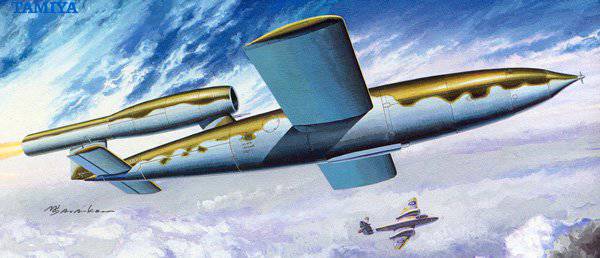
As of today, cruise missiles (KR) were massively used only four times (material from 1999 of the year):
- by fascist Germany in 1944-1945 against the cities of Great Britain as weapons "retaliation" for the bombing of German English cities aviation;
- The United States in 1991 during the Desert Storm air offensive against Iraq’s facilities as a “punishment” for this aggression against Kuwait;
- The United States and Britain in 1998 during the Desert Fox air offensive as a "punishment" of Saddam Hussein;
- The United States and Great Britain in 1999 during the Allied Force air offensive to "punish" the objectionable NATO and US Slobodan Milosevic, and with it the entire people of Yugoslavia.
It is obvious that in all these cases the use of cruise missiles was dictated not so much by military necessity as by political motives. Cruise missiles, as offensive weapons, fully preserved the ideology of the use of "weapons of retaliation," embedded in them by the propagandists of the Third Reich. At the same time, according to many military experts, the combat capabilities of the Kyrgyz Republic are greatly exaggerated by the propaganda of the attacking side. Thus, the possession of the CD turns into a political trump card. In order to beat this trump card, any state should be armed with less or more effective means of countering cruise missiles.
Balloon barriers during the Second World War were one of the most effective means of countering V-1 (V-1) cruise missiles.
These CDs, like the V-2 (V-2) ballistic missiles, became an instrument of total war, the theory of which was developed by fascist military experts. The new "miracle weapon" immediately became a weapon of state terrorism, since the missiles were launched not by military targets and groups of troops, but by large cities: London, Paris, Manchester, Antwerp, Liege and Brussels. In the summer of 1944, the command of the SS troops planned to strike V-1 missiles at Leningrad, Moscow, Kuibyshev, Chelyabinsk, Magnitogorsk. In January, 1945, the German leadership threatened Sweden, that it would use V-1 against Stockholm if the country went to war against Germany.
When the British were faced with the problem of V-1 missiles, at first it seemed to everyone that there was no way to deal with them. However, rather effective measures were developed to combat cruise missiles. In general, the air defense system overcame only 33% V-1. As for the V-2, the problem of combating them was not resolved until the Anglo-American troops pushed the Germans back more than the range of the missiles.
Now the situation has changed dramatically: the defending party has learned quite effectively how to deal with ballistic missiles, and the task of destroying modern cruise missiles is not sufficiently solved. Consequently, the experience of dealing with V-1, including with the help of balloon balloons, is very relevant.
What was the cruise missile (projectile) V-1? The V-1 fuselage had a length of 7,6 m and a diameter of 0,82 m. The total mass of the projectile was 2750 kg. A high explosive warhead with an 1000 kg (according to other data - 700 kg) of an explosive was placed in the nose. Behind the warhead was a tank with 80 octane gasoline. Then there were two spherical steel cylinders of compressed air braided with wire for the operation of the rudders and other mechanisms. The tail part was occupied by a simplified autopilot. Wingspan reached 5,4 m. Flight altitude ranged from 200 to 2000 meters, speed - to 800 kilometers per hour.
If necessary, the V-1 warhead could contain chemical warfare agents. The warhead of the V-1 may have assumed nuclear equipment - in the last 2 years of war, German scientists were actively working on the atomic bomb.
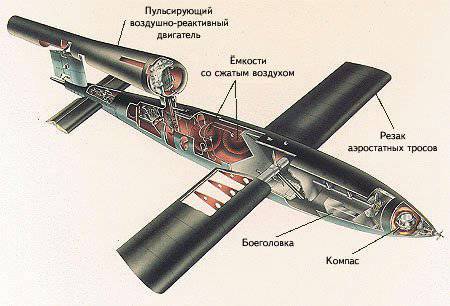
16 May 1944, the Wehrmacht Supreme Command issued an order for the combat use of V-1. In the evening of 12 on June 1944, German long-range cannons, located in the Calais region, began an unusually heavy shelling of British territory across the English Channel, diverting the attention of the British from the preparation of launching aircraft-shells. At 4 in the morning the shelling stopped. A few minutes later, a strange "plane" was noticed by the observation point in Kent, which made a sharp whistling sound and emitted a bright light from the tail section. The Plane did not dive on Kent, but continued flying over Downs. He fell to the ground with a deafening explosion in Swanskoum, near Gravesend, in 4 hours 18 minutes. Over the next hour, three more such "planes" fell in Cacfield, Bethnal Green and Platte. This was the beginning of the so-called "Robotolitsa" - the war of mechanisms.
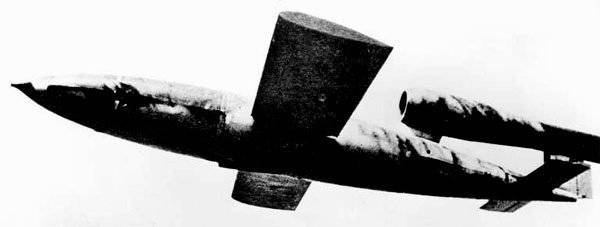
The main efforts of the British urgently transferred to the organization of the air defense of London, Bristol and the areas where the main forces of the allies were stationed to invade Normandy from missile aircraft. Back in December 1943, the British Air Defense Command began to develop a detailed defense plan against the V-1 - "Diver". Soon the circumstances required the preparation of another plan, which provided for the defense of the British cities and air cover for the Allies landing operations that had already begun.
The plan envisaged the creation of three air defense lines: on the first external frontier, V-1s were to be destroyed by fighter jets; on the second - anti-aircraft artillery; on the third - barrage balloons (AZ). To detect the V-1, it was planned to use an existing network of radar stations and ground-based observers.
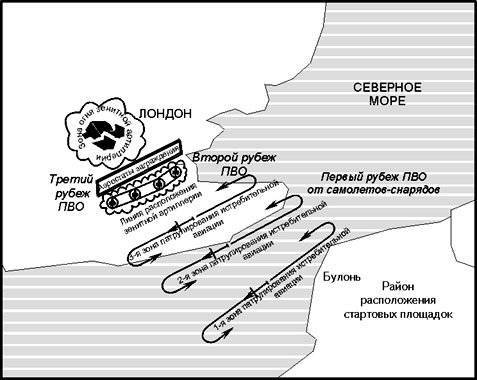
AZ envisaged to deploy immediately behind the line of anti-aircraft artillery in the number of 500 posts. The line of balloon posts was perpendicular to the V-1 flight routes.
Soon for the English command, it became apparent that the allocated amount of ground-based anti-V-1 weapons was not enough. London's air defense was reinforced with batteries removed from the defense of other cities. On June 28, 1 heavy and 363 light anti-aircraft guns participated in the reflection of the V-522 raid. Light anti-aircraft guns, anti-aircraft guns were deployed Tanks Royal Mechanized Corps and missile launchers. Urgent measures were taken to increase the number of AZ by 2 times.
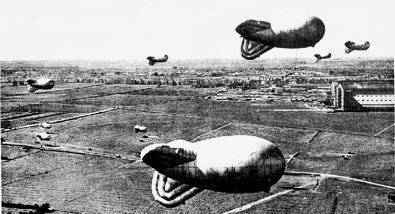
The Navy assisted the air defenses, sending ships to the French coast. They were 7 miles off the coast at intervals of 3 miles. Observers from the ships warned the fighter aircraft of the approaching V-1 with signal rockets and lighting projectiles. The flight time of the V-1 from the coast to the zone of anti-aircraft fire was 5 minutes, and from the zone of anti-aircraft fire to the AZ line - 1 a minute.
To improve the effectiveness of AZ, various adaptations to them were tried: nets, kites, and mustaches. But these devices hampered the work of the balloon post and had to be abandoned.
The most successful event aimed at increasing the effectiveness of air defense from airplanes, was the regrouping of anti-aircraft artillery from the vicinity of London directly to the coast. AZ remained in their places. As a result, the zone of action was divided into two parts: in front of an anti-aircraft artillery belt over the sea and between the same belt and aerostats of a barrier over land.
After regrouping the air defenses, one more CD was shot down in one week than in any previous week. August 28 was a turning point: from 97 KR, crossed the English Channel, 92 was destroyed, 4 reached London, and 3 fell, not reaching the city. Thus, in August, 1944, when the shelling of London V-1 reached its limit, the air defense achieved the greatest success: only individual KRs broke through to the capital. 29 March 1945. The last V-1 projectile landed on England.
German cruise missiles V-1 caused great damage to England: 24491 residential building was destroyed, 52293 buildings were uninhabitable. A 5864 person was killed, a 17197 was seriously injured and a 23174 person was slightly injured. On average, a single projectile that reached London and its environs, 10 killed and seriously wounded. In addition to London, Portsmouth, Southampton, Manchester and other cities of England were bombarded. Despite the fact that only half of the V-1 reached the goal, the strikes of the Kyrgyz Republic had a great moral and psychological effect on the population of England.
Aerostats barriers were, in essence, the last line of protection of London from the V-1. Despite the passive nature of their opposition, the 231 projectile crashed on their cables. Moreover, their greater number falls on the period when the intensity of the bombing was the greatest, and the air defense systems of anti-aircraft defense regrouped.
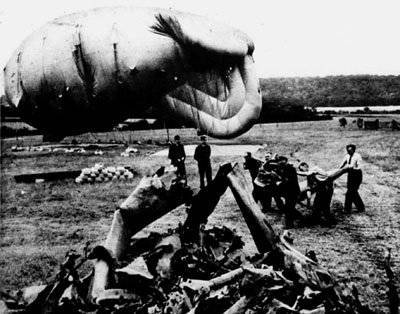
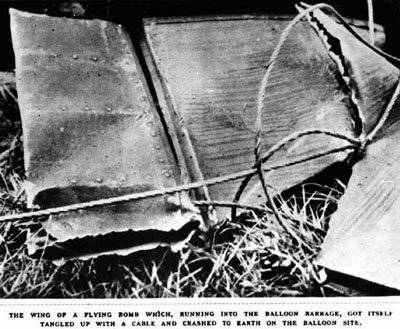
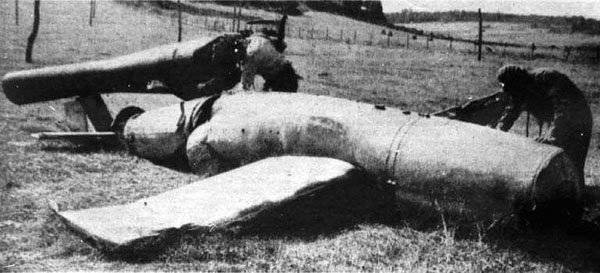
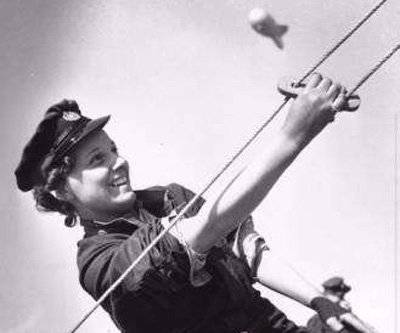

American military experts believed that if the Germans managed to improve their V-1 on 6 months earlier and apply them in areas where amphibious forces and assets were concentrated, this would make it extremely difficult or even impossible for the Anglo-American forces to invade France.
The Soviet command in 1944 has learned that the SS forces are planning to strike V-1 missiles at some cities. At the same time, in order to increase the flight range, reduce losses from air defense weapons and increase the accuracy of the strike, Hitler's command proposed using the manned variant of the cruise missile Fi 103 and suicide pilots. The famous terrorist operations specialist Otto Skorzeny has already given the order to recruit and train 250 such pilots.
19 July 1944, the Military Council of Artillery approved and sent to the Air Defense Forces "Advance directives to combat aircraft-shells." 10 August 1944. The Military Council of the Leningrad Air Defense Army approved a plan for the deployment of aviation and anti-aircraft equipment in the event that the enemy used V-1. September 22 in part of the air defense were sent out "Instructions on the fight with the aircraft-shells" V-1 ".
In the zone of responsibility of the Leningrad Army Air Defense, two sectors were created: the north-west and the south-west. The air defense systems were located in zones: the first was anti-aircraft artillery, the second was barrage balloons and the third was fighter aircraft. Against the V-1, four regiments of fighter aviation were distinguished, over 100 anti-aircraft batteries, over 100 anti-aircraft artillery batteries (418 guns) and more than 2000 AZ. The total depth of the air defense zone was 70-100 km.
AZ deployed in a new, unusual pattern. Post nominated for the city and compacted. Their interval was 300-400 m, lift height - up to 2 km. Thus, the density of the barrier was 6-7 cables per kilometer of the front with a total depth of the aerostat zone 8 km. Balloons were raised in the suburbs of Leningrad and on barges in the Gulf of Finland. In contrast to the usual protective AZ line, used to protect London, Soviet balloons, in addition to the main tether, had two side braces, which increase the likelihood of a KR raid on the striking elements of the AZ. Tether mine was equipped with explosive action. Were significantly compacted battle formations air warning system. 86 observation and company posts and 5 radar announced V-1 approaching at a distance of 120 km from Leningrad. Nazi troops did not have time to apply the flying bombs against the Soviet Union.
Very interesting is the comparative analysis of the English and Soviet balloon systems to counter V-1. First, in both cases, barrage balloons were used in close cooperation with fighter aircraft and anti-aircraft artillery. The only thing was that the air defense of London and Leningrad envisaged the creation of lines of three different forces: aviation, artillery and aerostats. Both in England and in the USSR, radar stations and ground observers were used to detect and report on the V-1 raid.
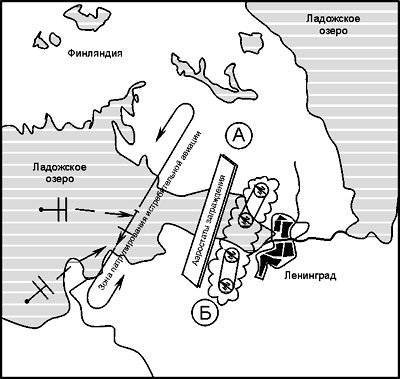
The difference - to protect London on the outer (first) line of the V-1 should have been destroyed by fighters; on the second - anti-aircraft artillery; on the third - barrage balloons. To protect Leningrad, anti-aircraft artillery was deployed at the third frontier, at the second - barrage balloons and at first - fighter aircraft. Each combat order had its advantages and disadvantages. In the English way the aerostats were assigned the role of a kind of final barrier to cruise missiles, which nevertheless broke through to the city. This was due to the fact that anti-aircraft artillery was forbidden to shoot down V-1 over the city (shot down by its explosion also caused damage). In the Soviet balloons capable of playing the role of a sieve. On the cruise missiles that passed through it, anti-aircraft artillery fire was to concentrate.
The main aerostat used in England against the V-1 was the MK-VII. Its design was developed shortly before the Second World War on the basis of an English artillery observation balloon. KO-1, KTN and BAZ-1 aerostats operated against the V-136 in Soviet airborne systems.
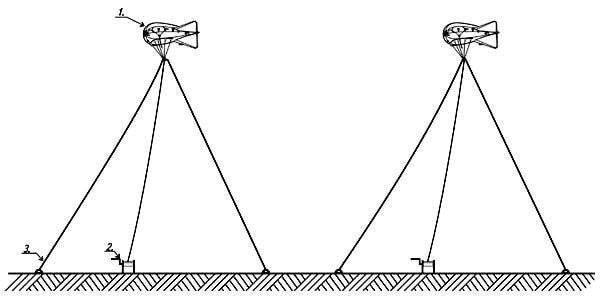
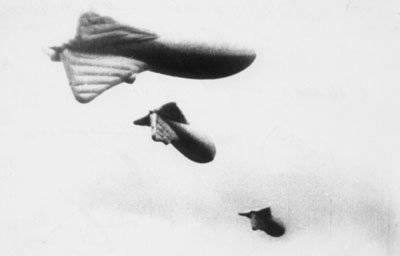
Thus, the first experience of the fight against cruise missiles shows that barrage balloons were used as an independent line of defense. However, the result achieved by the British in the fight against V-1 was provided by the integrated use of all anti-aircraft tools. At the same time, the interaction of intelligence and means of destruction, as well as maneuver by air defense systems, played a crucial role.
Only in less than four months of the raids of the German KR on London, the barrage balloons, as noted above, reliably destroyed the 231 rocket. This is about 3% of all fired missiles (it must be borne in mind that a significant part of the missiles did not reach London at all) and more than 8% of the total number of missiles shot down.
Number of KR, damaged cables AZ was probably much greater. This can be assumed from the fact that 231 KR was reliably destroyed only by the London aerostatic barrier system. Balloon barriers were deployed to protect many cities, including those in which the Nazis attacked the Kyrgyz Republic right up to 29 in March 1945. Undoubtedly, there was also a certain percentage of KR damaged by AA cables and finished with antiaircraft artillery and fighter aircraft. In addition, since the V-1 was an areal-type weapon, it is impossible to analyze the number of CDs that deviated from the original route and did not hit the target after colliding with AZ cables.
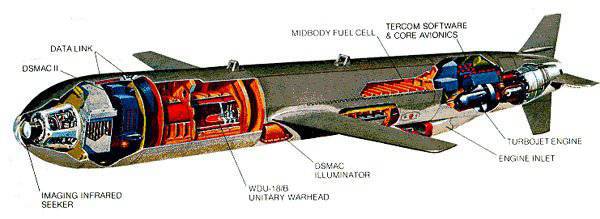
Interestingly, the modern CD differs from the V-1 only in the use of new materials, more advanced engines, greater flight range and higher pointing accuracy. Neither in terms of flight speed, nor in geometric dimensions, the German CUs practically do not differ from the same Tomahawk or the Russian CU X-55.
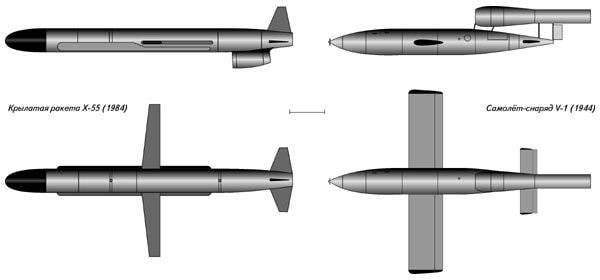
Consequently, we can make a confident conclusion that aerostat barriers will be no less effective in the fight against modern cruise missiles.
Information